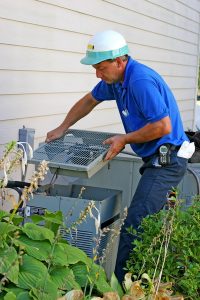
If you’ve come upon this blog post, it’s likely that you’re starting to look into an air conditioner replacement—or perhaps as we progress into spring you’ve realized that your heater is ready to call it quits and it’s time for an upgrade. No matter the situation, we really can’t stress enough how important it is that you not rush this purchase, and also, leave the installation job to the pros.
There are a number of reasons we advise this. For starters, there’s a lot of work that goes into each and every HVAC installation job we do, and this task contributes to your comfort and the efficiency of the system, not to mention the safety of your home and family. This is especially true if we’re talking about gas-powered heaters! Attempting to do such work yourself could lead to problems, similar to the dangers of trying to fix a furnace on your own, making professional help essential.
Read on as we uncover the steps that our technicians go through during an HVAC installation, so you can better understand why it’s so important to trust a pro.
Why is professional heating and air conditioning installation important?
Professional installation ensures your HVAC system is correctly sized, safely connected, and runs at peak efficiency. Technicians handle electrical and gas components, remove the old system properly, and optimize performance. This prevents future breakdowns, reduces energy costs, and extends the life of your new system.
Step 1: Removing the Old HVAC System Safely
This probably sounds like a simple enough step. But you can actually be unpleasantly surprised to learn that this is the most laborious part of the job, if you attempted it on your own. In most cases, it’s also the lengthiest part of the job. It’s about much more than simply pulling out the old system. If this is a heater we’re talking about, and it’s already connected to a gas line, then our techs have to make sure that nothing is damaged or knocked out of place during the removal process.
We’ll also need to check that the new HVAC system is properly sized for the space that it’s being installed in. We don’t just mean that it should be able to slide into place—we mean that it must not be underpowered or overpowered. This means we need to take a careful calculation otherwise you’ll be stuck with a highly inefficient HVAC system. Inefficiency can be costly over time, which is why extending the life of your HVAC system is critical, along with knowing when it’s time to replace it.
Step 2: Proper Electrical and Duct Connections Matter
Once the new HVAC system has been installed, and typically this means bolting it to the floor as well, our techs will connect the unit to the components needed for its operation. This includes your ductwork of course—in other words, your ventilation system. Your air ducts must be hooked up to the HVAC system correctly to avoid damaging them. Ductwork often has to be adjusted and shifted during this process, which is where mistakes can happen.
Next, our professionals hook up your HVAC system to its power source. If it’s a new gas-powered heater we’re putting in, we have your safety to consider. Any connections to a gas line requires an experienced and licensed professional to complete.
Lastly is the electrical wiring. Even a gas-powered heating system has electrical components. And with the potential for a fire hazard if this step isn’t done right, it’s easy to see why you should only trust a trained and experienced HVAC technician. For long-term safety and reliability, it’s important to schedule professional maintenance regularly to keep your system in optimal condition.
Step 3: System Testing for Performance and Safety
What kind of HVAC professionals would we be if we didn’t test your new system to make sure it worked as it should? If we left your home after making the last connection without turning the system on and measuring the output, we could be leaving you with and inefficient system—in other words, the job wouldn’t be completed!
An amateur can’t promise you complete work done well, but we can.
Frequently Asked Questions
Question: Why is professional HVAC installation so important?
Answer: A professional installation ensures your system is sized correctly, connected properly, and safely configured for your home’s specific needs. Inexperienced installation can lead to poor performance, inefficiency, even safety hazards.
Question: What can go wrong if I install HVAC myself or use unqualified help?
Answer: Mistakes during installation, such as incorrect connections, improper ductwork, or poor sizing, can cause inefficiencies, higher bills, system breakdowns and may also void warranties.
Question: How does using a professional affect system longevity and energy efficiency?
Answer: When a trained technician installs your HVAC system correctly, it runs more efficiently, wastes less energy, experiences less wear, and lasts longer.
Question: Why is compliance with safety and building codes part of the professional installation benefit?
Answer: Licensed installers know local codes, handle refrigerants, gas lines and electrical wiring safely, and ensure proper ventilation. This helps prevent hazards like leaks, fire or carbon monoxide exposure.
Question: What should I look for when choosing a professional HVAC installer?
Answer: Look for credentials, certifications, reviews and a clear process. Ensure the installer conducts a proper load calculation, assesses ductwork and offers warranties or maintenance support.
For quality Sandy Springs HVAC systems, and expert services to install them, contact DC Cheek Heating, Cooling & Plumbing.



